The Impact of the Green Economy on Carbon Emission Intensity: Comparisons, Challenges, and Mitigating Strategies
Abstract
1. Introduction
2. Literature Review
3. Study Area and Methodology
3.1. Study Area
3.2. Data Source
3.3. Methodology
3.3.1. Calculation Method of Total Carbon Emissions
3.3.2. Moran’s I
3.3.3. Geographically and Temporally Weighted Regression
4. Results
4.1. Calculation Results of Energy Carbon Emissions
4.2. Analysis of Influencing Factors
4.2.1. Spatio-Temporal Trend Analysis
4.2.2. Spatial Heterogeneity Analysis
4.3. Analysis of the Impact of Green Economic Development on Carbon Emissions
5. Discussion
- Data: Constrained by the logistics of data collection, this research omits certain provinces and special administrative regions in China (Tibet, Hong Kong Special Administrative Region, Taiwan Province, and Macao Special Administrative Region). Furthermore, given the lack of consensus on the meaning of a green economy, the indicator system employed for green economy development may lack exhaustive coverage and require further enhancement. The augmentation of indicators in subsequent investigations will therefore serve as a focal point of future research [49].
- Data processing: Research methods: In assessing the factors influencing carbon emissions across regions, this study employs the regression coefficient computed via the GTWR model to ascertain the impact of each driving component. This model proficiently quantifies the effects of spatial location and temporal instances, vividly illuminating the interplay among various factors within the model. However, the centroid determination of each region during the sample point selection could influence the choice of spatial distance weighting parameters. Future investigations could incorporate complementary methodologies to facilitate a comprehensive analysis, aiming to measure the influence of diverse factors on carbon emissions from a multidimensional standpoint [50]. Moreover, the spatiotemporal geographic weighted regression model employed in this study overlooks the cross-sectional correlation of panel data and falls short of pinpointing the spatial effect of green economy development on carbon emissions across different regions. Subsequent research will seek to expand our understanding of the effects of green economy development on carbon emissions, considering a wider range of perspectives aligned with the green economy concept.
- Research perspective: There are many types of energy consumption in China, with a complex composition. This paper used the main energy consumption, such as coal consumption, coke consumption, and diesel consumption, while ignoring the differences in energy consumption types among the 30 provinces and cities in China. In future research, energy carbon emissions should be considered from multiple perspectives [51].
- Research methods: The GTWR model used in the empirical analysis of this paper is a single model, and other parameter optimization methods will be added in subsequent research to improve the accuracy of the model and combined with other models for more comprehensive analyses [52].
6. Conclusions
6.1. Main Conclusion
- Overall, China’s carbon emissions have displayed an upward trajectory; however, the rate of growth has noticeably decelerated since 2011. Carbon emissions in the northwest are comparatively minimal with a marginal growth rate. Central and Northernnorthern China exhibit high carbon emission intensity, yet the growth rate from 2012 to 2020 is inferior to that from 2004 to 2011, with some regions even demonstrating a declining trend in emissions. With the maturation of the green economy development model, the surge in carbon emissions has decelerated. Throughout the study period, significant spatial clustering of carbon emissions has been observed in various regions, with most areas residing in high-value and low-value regions.
- An analysis of the influencing factors on carbon emissions in 30 Chinese provinces and cities from 2004 to 2020 reveals that the overall impact of economic development indicators on carbon emissions presents a pattern of initial decrease followed by increase. Although China’s economic growth is steadily transitioning from extensive to intensive, striving for high-quality economic growth, the effectiveness of environmental protection remains unproven, and economic development continues to rely on the utilization of fossil fuels, thereby perpetuating carbon emissions growth. The coefficient of social development has seen an annual increase. Human production and lifestyle are irrevocably tied to energy consumption, particularly the consumption of fossil fuels, which yield substantial carbon emissions. Given that rural residents currently consume less energy than urban residents in their daily lives, transportation, and other areas, an increase in urbanization rate incites a rise in energy consumption, thereby augmenting energy carbon emissions. The green coverage rate in built-up areas within the ecological environment follows a pattern of initial increase and subsequent decrease, and the influence of per capita park green space area shows a downward trend. The overall effect of government policies on carbon dioxide emissions reduction exhibits a significant upward trend.
- Spatial heterogeneity analysis conducted on the research subjects concludes that distinct driving factors exert varied degrees of impact across different regions. Overall, economic development significantly contributes to emission reduction in the northwest and southwest of China, while social development escalates carbon emissions in all areas, particularly in Northernnorthern and Easterneastern China. The ecological environment fosters carbon emissions in Northernnorthern and Easterneastern China. Government policies, on the whole, play a critical role in carbon dioxide emissions reduction, especially in Northernnorthern China. These findings illuminate some fundamental realities of China’s rapid development process: the majority of provinces and cities are preoccupied with bolstering their economic prowess and expediting social development while placing less emphasis on environmental protection. Consequently, economic and social development instigates an increase in carbon emissions in such areas.
- A comparative analysis before and after the definition of the green economy by the United Nations Environment Programme reveals a significant change in the upgrading coefficient of the industrial structure from an economic development perspective. Compared to the primary and secondary sectors, the tertiary sector consumes less energy per unit of output. Thus, the upgrading of the industrial structure curtails energy consumption, thereby reducing carbon emissions. The coefficients of the three indicators in social development have all seen an increase, and the per capita urban road area in the ecological environment has transitioned from positive to negative, significantly aiding carbon dioxide emissions reduction. Both the scientific and technological expenditure of government policies and the harmless treatment rate of household waste are negative and have increased in absolute terms, suggesting an enhanced contribution to carbon dioxide emissions reduction.
6.2. Countermeasure Suggestions
- Given the temporal lag in carbon emissions, the quality of early environmental governance critically influences the execution of current low-carbon emission reduction initiatives. Therefore, to achieve the objective of sustainable green and low-carbon development, it is imperative to focus not only on national-level carbon emission control and total emission management in each phase but also from a local perspective. This involves intensive monitoring of provinces and regions with high emissions, coupled with prompt elimination of peripheral pollution radiation.
- Within the sphere of carbon dioxide emission reduction, on the one hand, the share of the tertiary sector in the economy should be augmented through industrial structure optimization and the advancement of high-tech industries. On the other hand, the commitment to scientific and technological investment needs to be heightened, thereby accelerating technological innovation, transforming the structure of energy utilization, and expanding the proportion of clean and renewable energy use. As China is a high energy-consuming nation, enhancing the conversion rate of primary energy consumption can drastically decrease overall carbon emissions. An improvement in energy utilization rate will have a profound positive impact on carbon emissions.
- All regions within China need to enact differentiated carbon emissions management, tailored to local conditions. Various regions must implement divergent carbon emission management policies and develop carbon reduction strategies compatible with their unique realities. For instance, the northwestern region requires an intensification of governmental efforts, an increase in scientific and technological expenditure, and further advancements in energy-saving and emission-reduction technologies. Simultaneously, Northnorth China, while fostering economic growth, must reinforce environmental protection measures and balance the interface between economy and environment. This approach to differential management of carbon emissions can create a conducive environment for regional emission reduction and facilitate autonomous emission reduction in each jurisdiction.
- The progression of the green economy can not only elevate the standards of environmental protection technology and capabilities but also stimulate the development of renewable energy, catalyze the transformation and upgrading of the energy industry, and effectively mitigate carbon emissions. China should fortify its commitment to the development of the green economy, enhance environmental law enforcement, progressively construct a comprehensive and efficient legal framework for the green economy, and provide systematic institutional guarantees for the development of the green economy.
Author Contributions
Funding
Institutional Review Board Statement
Informed Consent Statement
Data Availability Statement
Conflicts of Interest
References
- Zhai, S.Y.; Wang, Z.; Ma, X.Z.; Huang, R.; Liu, C.X.; Zhu, Y.B. Calculation of regional carbon emission: A case of Guangdong Province. Yingyong Sheng Tai Xue Bao 2011, 22, 1543–1551. [Google Scholar]
- Li, S.; Lan, Y.W.; Guo, L.J. Analysis of Carbon Emission and Its Temporal and Spatial Distribution in County-Level: A Case Study of Henan Province, China. Nat. Environ. Pollut. Technol. 2022, 21, 447–456. [Google Scholar] [CrossRef]
- Wang, X.; Wang, Z.; Wang, R. Does green economy contribute towards COP26 ambitions? Exploring the influence of natural resource endowment and technological innovation on the growth efficiency of China’s regional green economy. Resour. Policy 2023, 80, 103189. [Google Scholar] [CrossRef]
- Yang, Y.L.; Zhang, X.; Wu, T. Does Public Participation Reduce Regional Carbon Emissions? A Quasi-Natural Experiment from Environmental Information Disclosure in China. Pol. J. Environ. Stud. 2023, 2, 1899–1917. [Google Scholar] [CrossRef]
- Imansyah, M.H.; Hartono, D.; Putranti, T.; Muzdalifah, M. The Impacts of Digital Economy on Green Economy: The Indonesian Miyazawa Model. Pol. J. Environ. Stud. 2023, 32, 1609–1619. [Google Scholar] [CrossRef]
- Feng, M.; Lan, L.; Chen, C.; Zhu, Y.Q. Spatial Effect Research on the Impact of Technological Innovation on Carbon Dioxide Emission Intensity. Pol. J. Environ. Stud. 2022, 31, 5675–5682. [Google Scholar] [CrossRef]
- Hu, X.; Zhang, X.; Dong, L.; Li, H.; He, Z.; Chen, H. Carbon Emission Factors Identification and Measurement Model Construction for Railway Construction Projects. Int. J. Environ. Res. Public Health 2022, 19, 11379. [Google Scholar] [CrossRef]
- Xiao, Y.; Huang, H.; Qian, X.M.; Zhang, L.Y.; An, B.W. Can new-type urbanization reduce urban building carbon emissions? New evidence from China. Sustain. Cities Soc. 2023, 90, 2210–6707. [Google Scholar] [CrossRef]
- Wang, G.Y.; Zhou, J.S. Energy endowment, energy capacity aggregation and carbon emissions in China-empirical analysis based on spatial Durbin model. Front. Environ. Sci. 2022, 10, 1769. [Google Scholar] [CrossRef]
- Sharma, S.S. Determinants of carbon dioxide emissions: Empirical evidence from 69countries. Appl. Energy 2011, 88, 376–382. [Google Scholar] [CrossRef]
- Murshed, M. An empirical analysis of the non-linear impacts of ICT-trade openness on renewable energy transition, energy efficiency, clean cooking fuel access and environmental sustainability in South Asia. Environ. Sci. Pollut. Res. 2020, 27, 36254–36281. [Google Scholar] [CrossRef] [PubMed]
- Yeh, J.; Liao, C. Impact of population and economic growth on carbon emissions in Taiwan using an analytic tool STIRPAT. Sustain. Environ. Res. 2017, 27, 41–48. [Google Scholar] [CrossRef]
- Shao, Y. Does FDI affect carbon intensity? New evidence from dynamic panel analysis. Int. J. Clim. Chang. Strateg. Manag. 2017, 10, 27–42. [Google Scholar] [CrossRef]
- Fan, J.Q.; Hu, W.R.; Wu, Y.G.; Zhou, R.P. Analysis of Characteristics and Factors Influencing Urban Carbon Emissions Based on Decoupling Index and LMDI, Using Ordos City in Inner Mongolia as an Example. Pol. J. Environ. Stud. 2022, 31, 5649–5660. [Google Scholar] [CrossRef]
- Guo, F.P.; Zhang, L.J.; Wang, Z.F.; Ji, S.B. Research on Determining the Critical Influencing Factors of Carbon Emission Integrating GRA with an Improved STIRPAT Model: Taking the Yangtze River Delta as an Example. Int. J. Environ. Res. Public Health 2022, 19, 8791. [Google Scholar] [CrossRef]
- Wang, L.H.; Yin, K.D.; Cao, Y.; Li, X.M. A New Grey Relational Analysis Model Based on the Characteristic of Inscribed Core (IC-GRA) and Its Application on Seven-Pilot Carbon Trading Markets of China. Int. J. Environ. Res. Public Health 2018, 16, 99. [Google Scholar] [CrossRef] [PubMed]
- Shahbaz, M.; Adnan, H.Q.M.; Kumar, T.A.; Leitao, N.C. Economic growth, energy consumption, financial development, international trade and CO2 emissions in Indonesia. Renew. Sustain. Energy Rev. 2013, 25, 231–242. [Google Scholar] [CrossRef]
- Zeng, S.; Wang, M. Theoretical and empirical analyses on the factors affecting carbon emissions: Case of Zhejiang Province, China. Environ. Dev. Sustain. 2023, 25, 2522–2549. [Google Scholar] [CrossRef]
- Tao, A.X. Study on the path of coordinated development between carbon emission reduction and economy in Guangdong Province. Energy Rep. 2022, 6, 477–481. [Google Scholar] [CrossRef]
- Wang, Z.; Yin, F.; Zhang, Y.; Zhang, X. An empirical research on the influencing factors of regional CO2 emissions: Evidence from Beijing city, China. Appl. Energy 2012, 100, 277–284. [Google Scholar] [CrossRef]
- Hardt, L.; Owen, A.; Brockway, P.; Heun, M.K.; Barrett, J.; Taylor, P.G.; Foxon, T.J. Untangling the drivers of energy reduction in the UK productive sectors: Efficiency or offshoring? Appl. Energy 2018, 223, 124–133. [Google Scholar] [CrossRef]
- Guo, M.Y.; Chen, S.L.; Zhang, J.; Meng, J. Environment Kuznets Curve in transport sector’s carbon emission: Evidence from China. J. Clean. Prod. 2022, 371, 133504. [Google Scholar] [CrossRef]
- Wen, M.; Li, M.X.; Erum, N.; Hussain, A.; Xie, H.Y.; Khan, H.S. Revisiting Environmental Kuznets Curve in Relation to Economic Development and Energy Carbon Emission Efficiency: Evidence from Suzhou, China. Energies 2022, 15, 62. [Google Scholar] [CrossRef]
- Grossman, G.M.; Krueger, A.B. Environmental Impacts of a North American Free trade Agreement. Soc. Sci. Electron. Publ. 1991, 8, 223–250. [Google Scholar] [CrossRef]
- Frank, B.; Philipp, P. Global Environmental Governance: Taking Stock, Moving Forward. Annu. Rev. Environ. Resour. 2008, 33, 277–294. [Google Scholar] [CrossRef]
- Nourhane, H.; Dalia, M.I.; Sanhita, S.; Khadiga, M.E.; Rehab, R.E.; Narayan, S. Assessing the role of green economy on sustainable development in developing countries. Heliyon 2023, 6, 2405–8440. [Google Scholar] [CrossRef]
- Munitlak, I.O.; Zubovic, J.; Mitic, P. Relationship Between Sustainable Development and Green Economy-emphasis on Green Finance and Banking. Ekon. Poljopr.-Econ. Agric. 2017, 4, 1467–1482. [Google Scholar] [CrossRef]
- Yu, B.; Fang, D.; Kleit, A.N.; Xiao, K. Exploring the Driving Mechanism and the Evolution of the Low-Carbon Economy Transition: Lessons from OECD developed Countries. World Econ. 2022, 45, 1. [Google Scholar] [CrossRef]
- Jiang, J.H. The decomposition and policy meaning of China’s carbon emission intensity. Evol. Institutional Econ. Rev. 2017, 14, 295–310. [Google Scholar] [CrossRef]
- Gan, C.; Wang, K.; Voda, M. Decoupling relationship between carbon emission and economic development in the service sector: Case of 30 provinces in China. Environ. Sci. Pollut. Res. 2022, 29, 63846–63858. [Google Scholar] [CrossRef]
- Wu, X.; Liao, H. A gained and lost dominance score method with conflict analysis for green economy development evaluation. Ann. Oper. Res. 2022, 316, 623–655. [Google Scholar] [CrossRef]
- Zheng, W.D.; Zhang, L.N.; Hu, J.B. Green credit, carbon emission and high quality development of green economy in China. Energy Rep. 2022, 8, 12215–12226. [Google Scholar] [CrossRef]
- Hou, C.; Chen, H.; Long, R. Coupling and coordination of China’s economy, ecological environment and health from a green production perspective. Int. J. Environ. Sci. Technol. 2022, 19, 4087–4106. [Google Scholar] [CrossRef]
- Zhang, F.; Qi, Y. Research on the Performance Evaluation Index System Construction and Countermeasure of Low-carbon Economic Development in China. IOP Conf. Ser. Earth Environ. Sci. 2020, 440, 042058. [Google Scholar] [CrossRef]
- Dou, C.B.; Zheng, L.; Wang, W.J.; Shabaz, M. Evaluation of Urban Environmental and Economic Coordination Based on Discrete Mathematical Model. Math. Probl. Eng. 2021, 2021, 1566538. [Google Scholar] [CrossRef]
- Wang, M.; Zhao, X.L.; Gong, Q.X.; Ji, Z.G. Measurement of Regional Green Economy Sustainable Development Ability Based on Entropy Weight-Topsis-Coupling Coordination Degree—A Case Study in Shandong Province, China. Sustainability 2019, 11, 280. [Google Scholar] [CrossRef]
- Rao, C.J.; Gao, Y. Evaluation Mechanism Design for the Development Level of Urban-Rural Integration Based on an Improved TOPSIS Method. Mathematics 2022, 10, 380. [Google Scholar] [CrossRef]
- Shi, B.F.; Yang, H.F.; Wang, J.; Zhao, J.X. City Green Economy Evaluation: Empirical Evidence from 15 Sub-Provincial Cities in China. Sustainability 2016, 8, 551. [Google Scholar] [CrossRef]
- Meng, B.; Chi, G.T. Evaluation index system of green industry based on maximum information content. Singap. Econ. Rev. 2018, 63, 229–248. [Google Scholar] [CrossRef]
- Zhang, F.; Wang, X.; Liu, X. Research on Functional Value Estimation and Development Mode of Green Infrastructure Based on Multi-Dimensional Evaluation Model: A Case Study of China. Land 2022, 11, 1603. [Google Scholar] [CrossRef]
- Wang, S.; Wang, X.; Lu, B. Is resource abundance a curse for green economic growth? evidence from developing countries. Resour. Policy 2022, 75, 102533. [Google Scholar] [CrossRef]
- Taedong, L.; Jeroen, V.D.H. Does the knowledge economy advance the green economy? an evaluation of green jobs in the 100 largest metropolitan regions in the United States. Energy Environ. 2019, 30, 141–155. [Google Scholar] [CrossRef]
- Alan, B.; Pawel, D.; Sebastian, B.; Krzysztof, S.; Szymon, C. Efficiency of Environmental Protection Expenditures in EU Countries. Energies 2021, 14, 8443. [Google Scholar] [CrossRef]
- Shen, J.; Sun, Y. Index System for the Evaluation of Regional Green GDP Based on DPSIR Model. Hohai Univ. J. Hohai Univ. 2016, 61–66, 100–101. Available online: https://kns.cnki.net/KCMS/detail/detail.aspx?dbname=cjfd2016&filename=hhzx201606010&dbcode=cjfq (accessed on 12 June 2023).
- Liu, X.; Pei, T.; Zhou, C.; Du, Y.; Ma, T.; Xie, C.; Xu, J. A systems dynamic model of a coal-based city with multiple adaptive scenarios: A case study of ordos, China. Sci. China Earth Sci. 2018, 61, 15. [Google Scholar] [CrossRef]
- Huang, H.; Zhou, J. Study on the Spatial and Temporal Differentiation Pattern of Carbon Emission and Carbon Compensation in China’s Provincial Areas. Sustainability 2022, 14, 7627. [Google Scholar] [CrossRef]
- Huang, B.; Wu, B.; Barry, M. Geographically and temporally weighted regression for modeling spatiotemporal variation in house prices. Int. J. Geogr. Inf. Sci. 2010, 24, 383–401. [Google Scholar] [CrossRef]
- Li, G.l.; Zong, J. Research on the Impact of Energy Conservation and Environmental Protection Expenditures on Carbon Emissions from the Perspective of Fiscal Decentralization. J. Lanzhou Univ. Financ. Econ. 2021, 1, 83–94. (In Chinese). Available online: https://kns.cnki.net/KCMS/detail/detail.aspx?dbname=cjfd2021&filename=sxgz202101008&dbcode=cjfq (accessed on 12 June 2023).
- Jaruwan, C. Driving forces of energy-related co 2 emissions based on expanded IPAT decomposition analysis: Evidence from ASENA and four selected countries. Energies 2019, 12, 764. [Google Scholar] [CrossRef]
- Nasir, M.A.; Canh, N.P.; Lan, T.N. Environmental degradation & role of financialisation, economic development, industrialisation and trade liberalisation. J. Environ. Manag. 2021, 277, 111471. [Google Scholar] [CrossRef]
- Huang, J.H.; Duan, W.Y.; Zhou, Q.; Zeng, H. Methodology for carbon emission flow calculation of integrated energy systems. Energy Rep. 2022, 8, 1090–1097. [Google Scholar] [CrossRef]
- Xu, R.F.; Gao, J.Z. Evolutionary Trends, Regional Differences and Influencing Factors of the Green Efficiency of Agricultural Water Use in China Based on WF-GTWR Model. Int. J. Environ. Res. Public Health 2023, 20, 1946. [Google Scholar] [CrossRef] [PubMed]
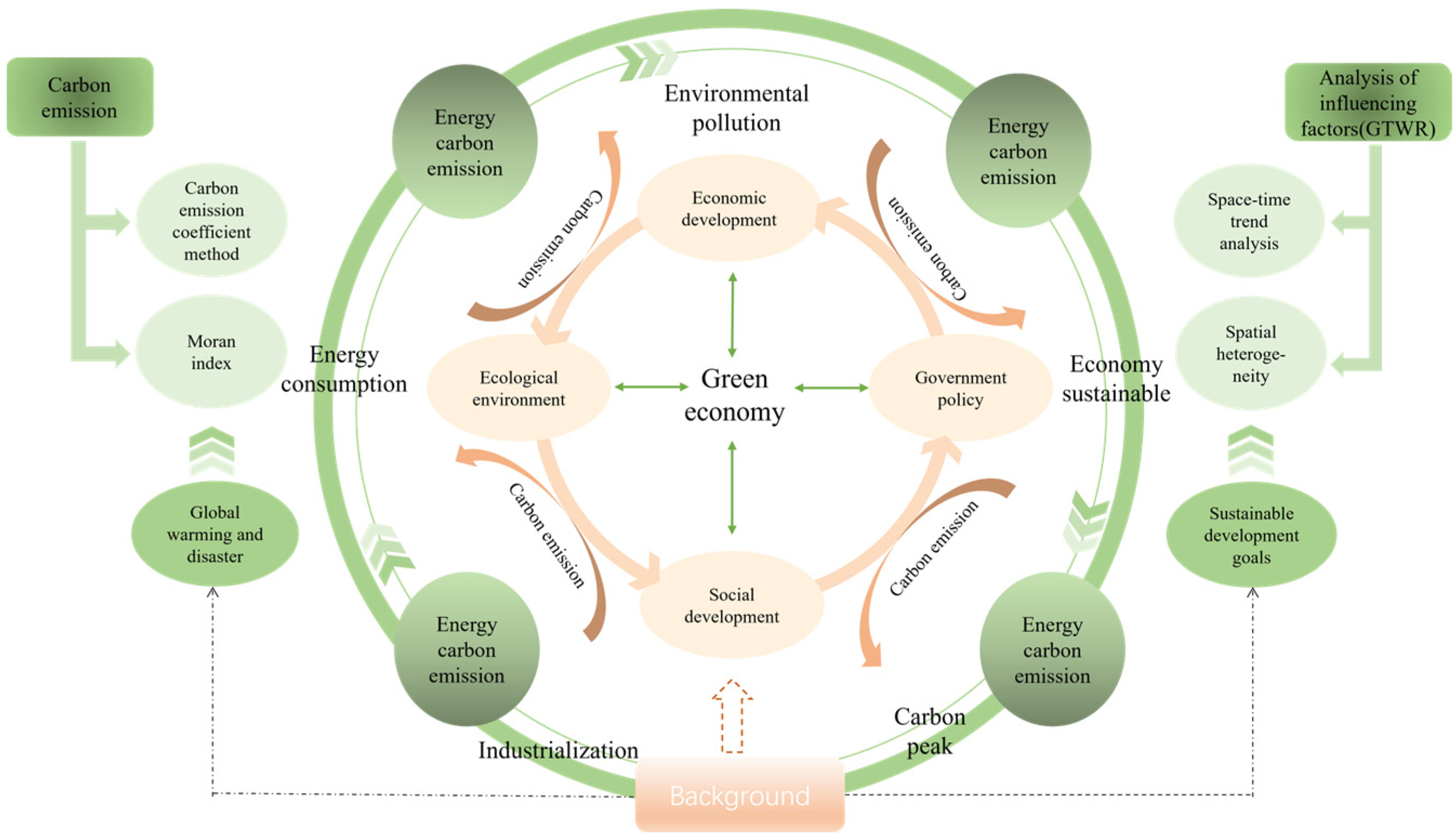
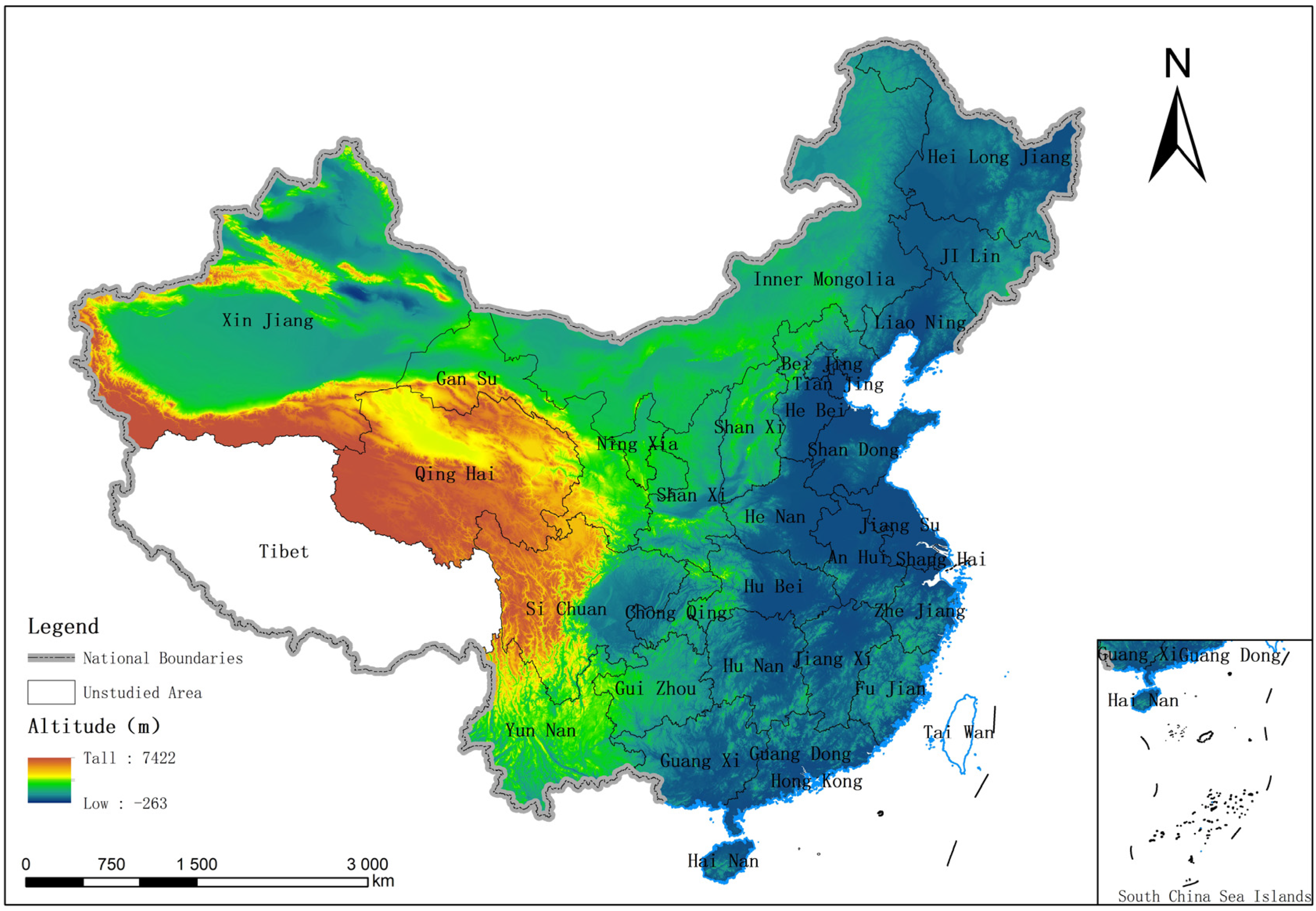

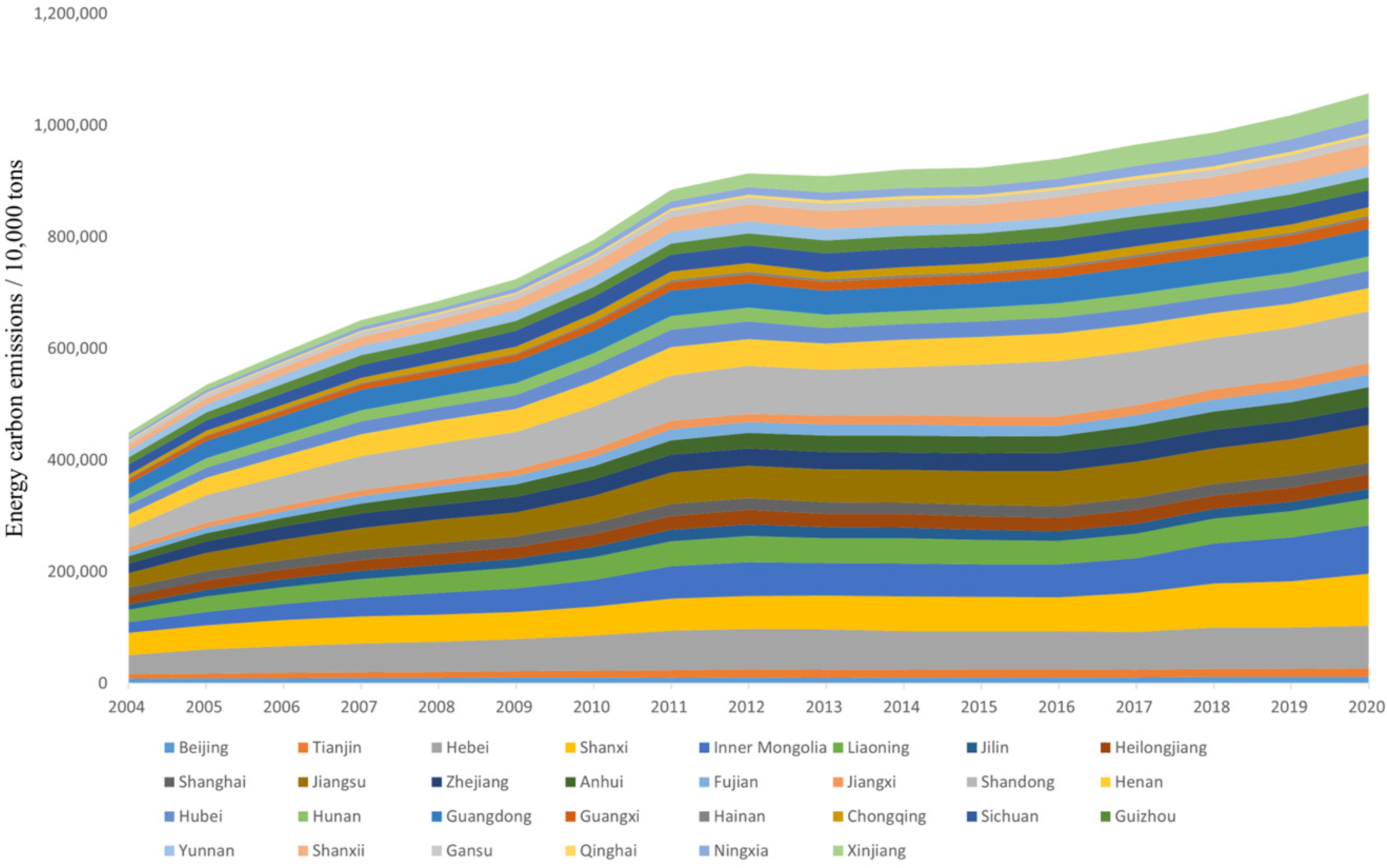
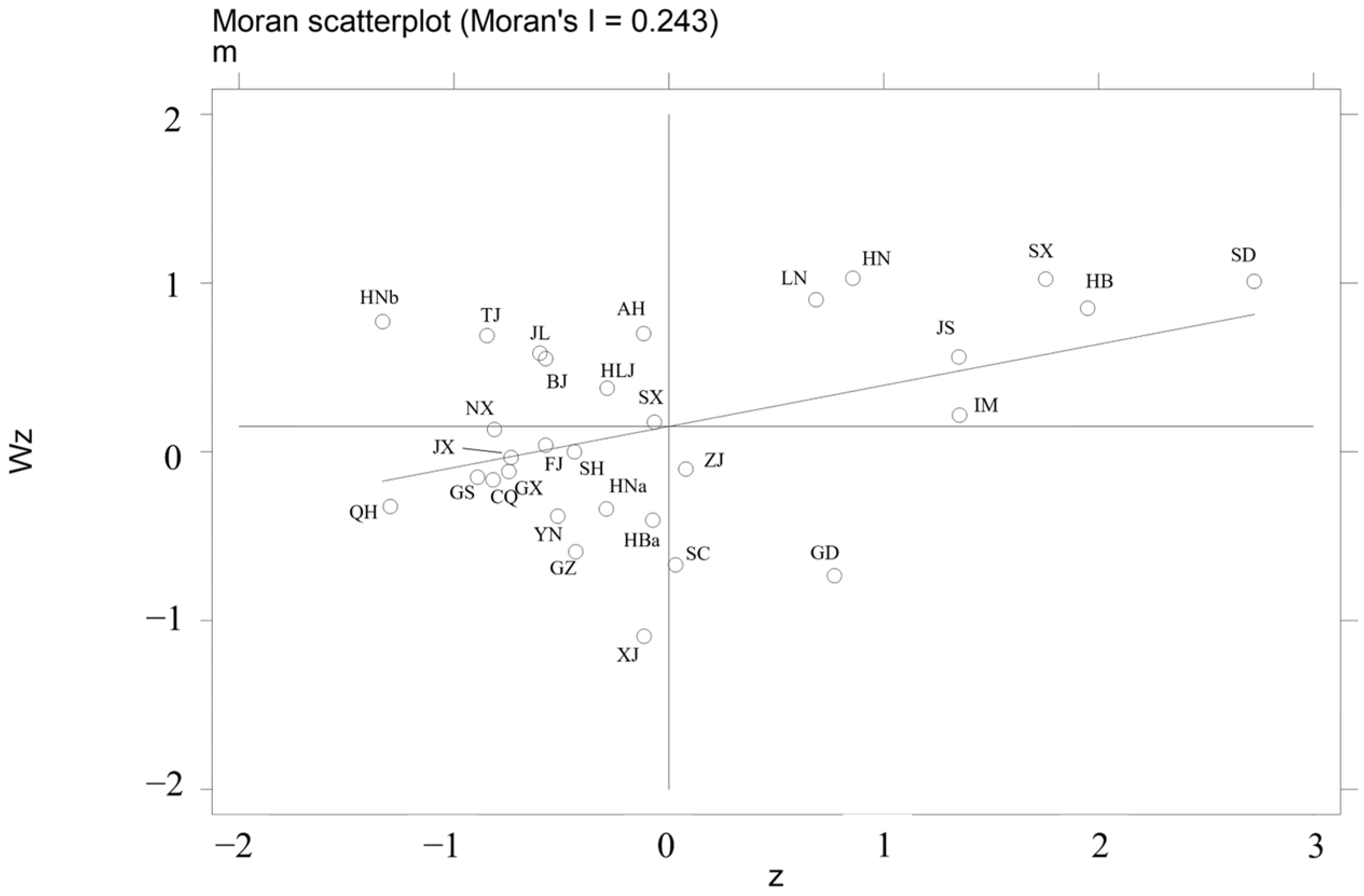
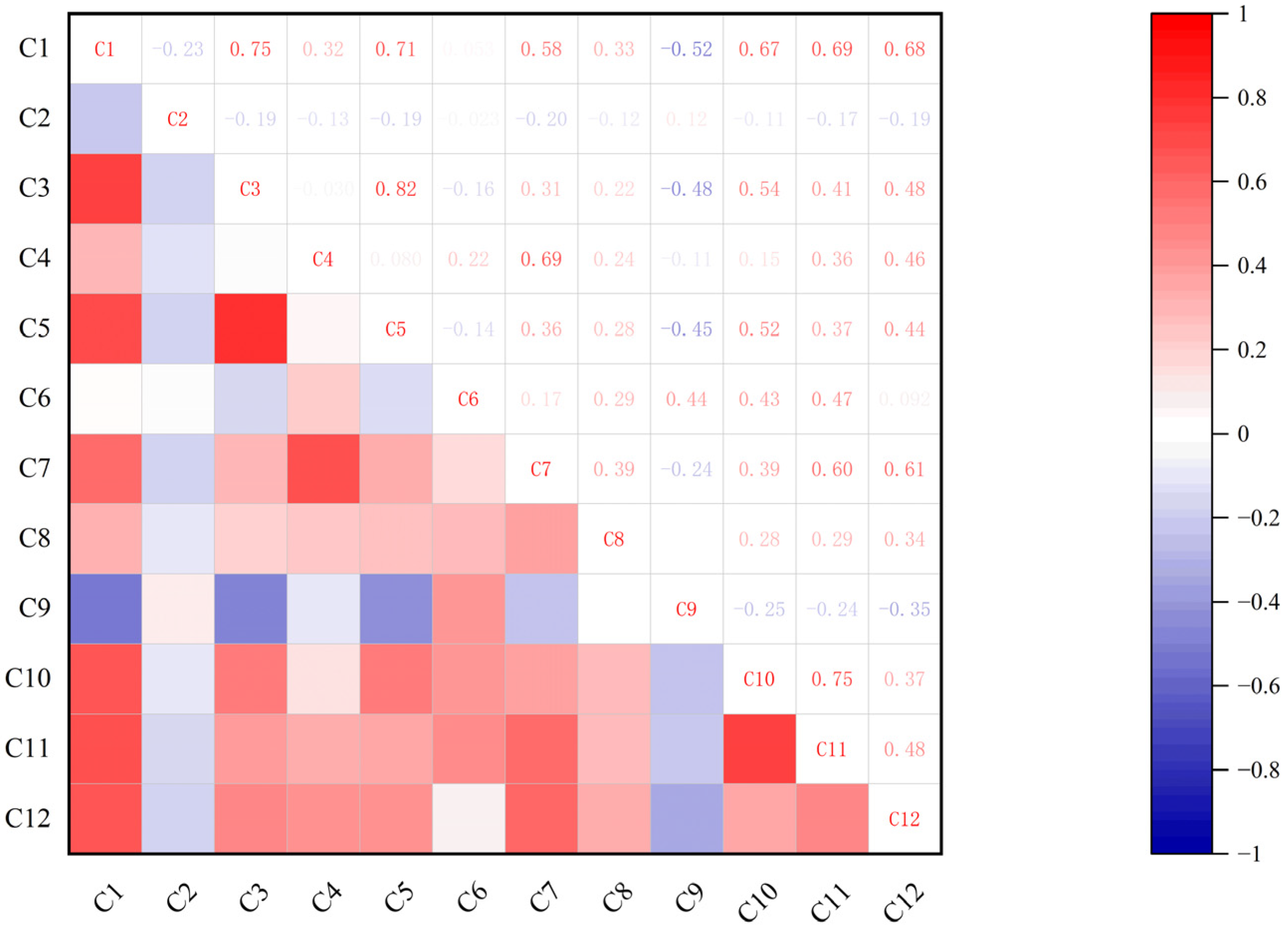

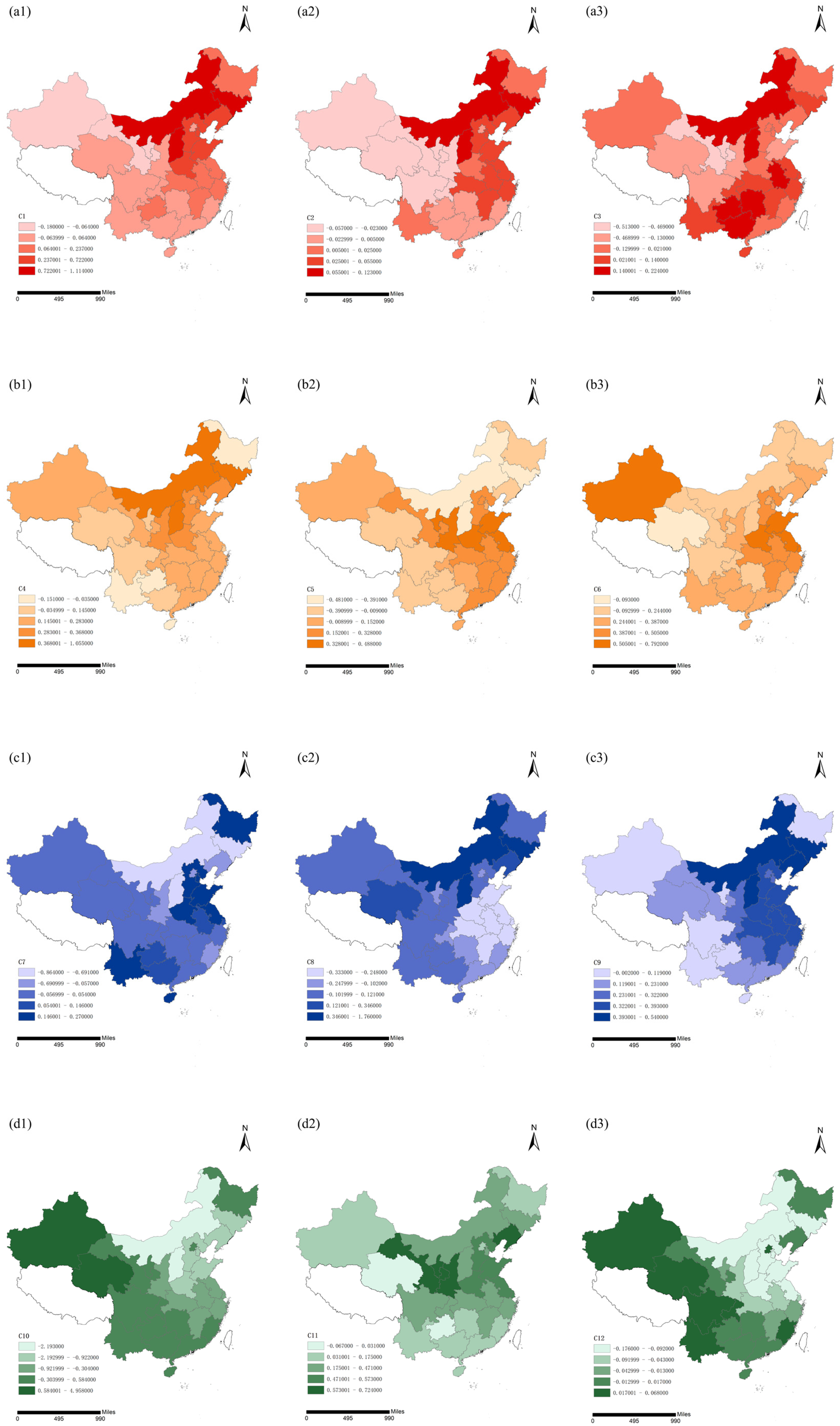
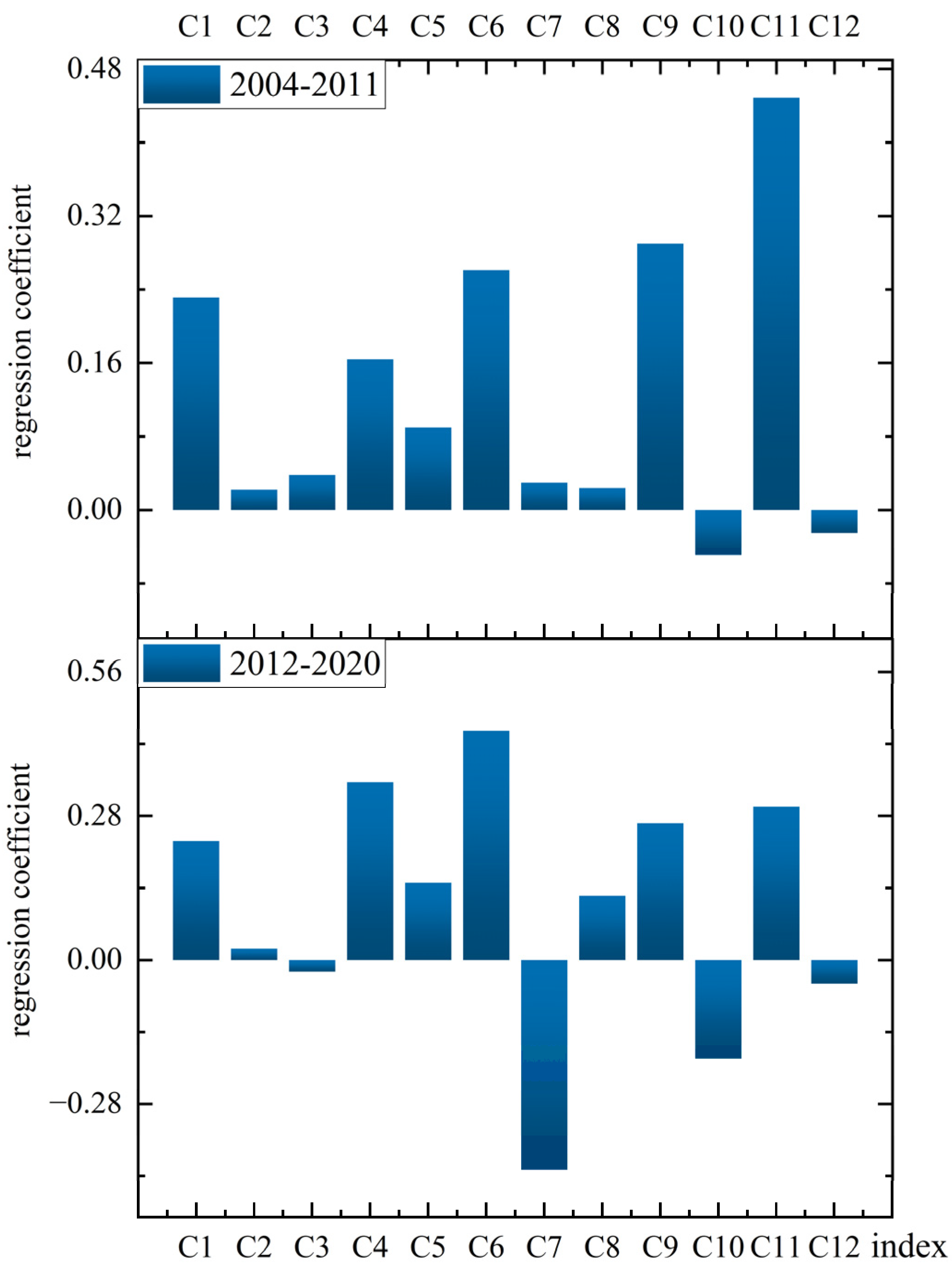

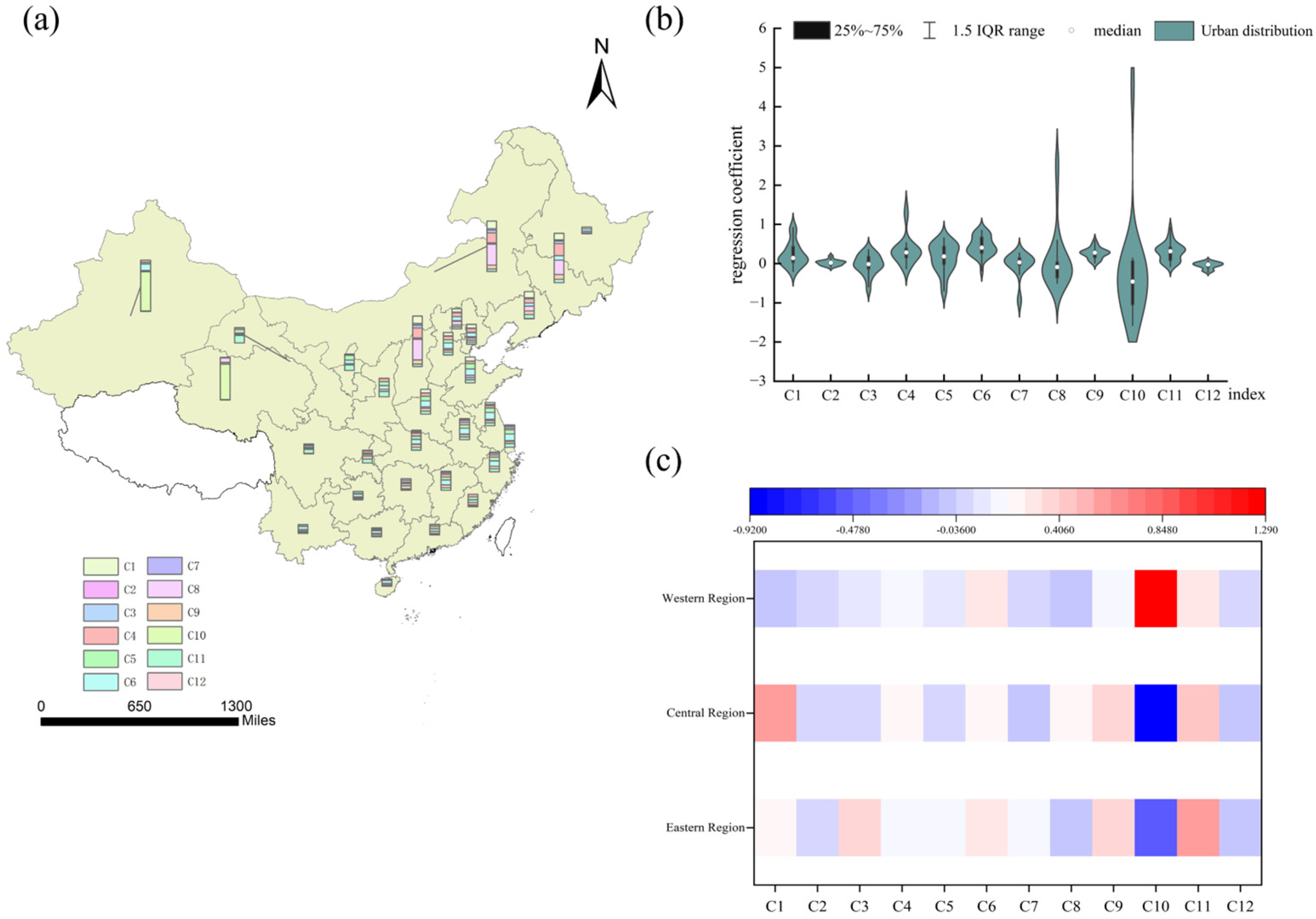
| Target Layer (A) | Criterion Layer (B) | Indicator Identification | Index Layer (C) | Unit | Indicator Identification | Reference |
|---|---|---|---|---|---|---|
| Green economy | Economic development | B1 | Consumer price index (CPI) | % | C1 | [35] |
| Per capita disposable income | CNY | C2 | [32] | |||
| Industrial structure upgrading coefficient | C3 | [33] | ||||
| Social development | B2 | Road area per citizen | m2 | C4 | [36] | |
| Urbanization rate | % | C5 | [37] | |||
| Population size | people | C6 | [38] | |||
| Ecological environment | B3 | Per capita park green area | m2/people | C7 | [39] | |
| Greenery coverage rate of built-up area | % | C8 | [40] | |||
| Sulfur dioxide emissions | 104 tons | C9 | [41] | |||
| Government policy | B4 | Science and technology expenditure | 108 CNY | C10 | [42] | |
| Environmental protection expenditure | 108 CNY | C11 | [43] | |||
| Decontamination rate of urban refuse | % | C12 | [44] |
Disclaimer/Publisher’s Note: The statements, opinions and data contained in all publications are solely those of the individual author(s) and contributor(s) and not of MDPI and/or the editor(s). MDPI and/or the editor(s) disclaim responsibility for any injury to people or property resulting from any ideas, methods, instructions or products referred to in the content. |
© 2023 by the authors. Licensee MDPI, Basel, Switzerland. This article is an open access article distributed under the terms and conditions of the Creative Commons Attribution (CC BY) license (https://creativecommons.org/licenses/by/4.0/).
Share and Cite
Peng, J.; Hu, X.; Fan, X.; Wang, K.; Gong, H. The Impact of the Green Economy on Carbon Emission Intensity: Comparisons, Challenges, and Mitigating Strategies. Sustainability 2023, 15, 10965. https://doi.org/10.3390/su151410965
Peng J, Hu X, Fan X, Wang K, Gong H. The Impact of the Green Economy on Carbon Emission Intensity: Comparisons, Challenges, and Mitigating Strategies. Sustainability. 2023; 15(14):10965. https://doi.org/10.3390/su151410965
Chicago/Turabian StylePeng, Jia, Xianli Hu, Xinyue Fan, Kai Wang, and Hao Gong. 2023. "The Impact of the Green Economy on Carbon Emission Intensity: Comparisons, Challenges, and Mitigating Strategies" Sustainability 15, no. 14: 10965. https://doi.org/10.3390/su151410965
APA StylePeng, J., Hu, X., Fan, X., Wang, K., & Gong, H. (2023). The Impact of the Green Economy on Carbon Emission Intensity: Comparisons, Challenges, and Mitigating Strategies. Sustainability, 15(14), 10965. https://doi.org/10.3390/su151410965





